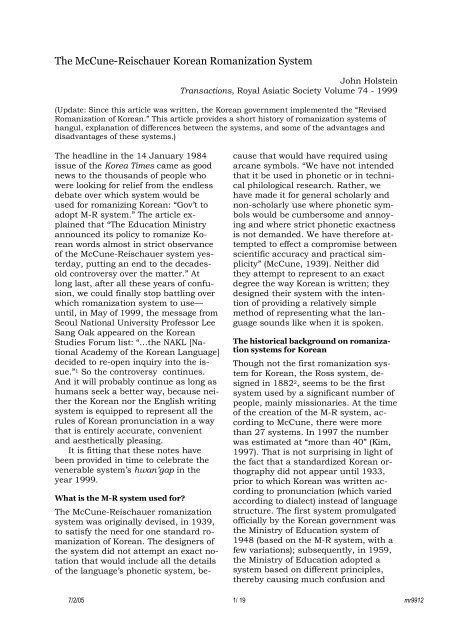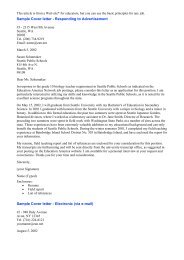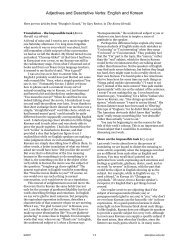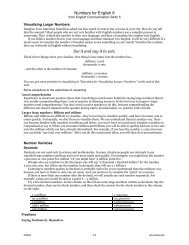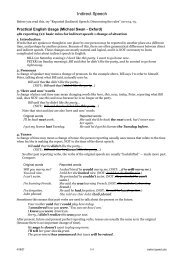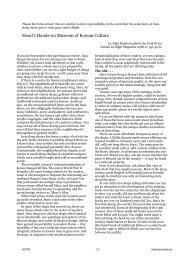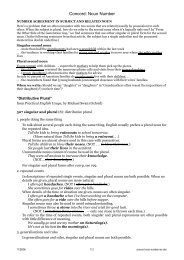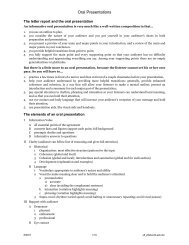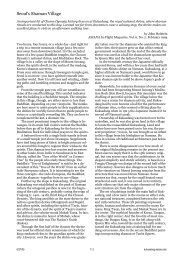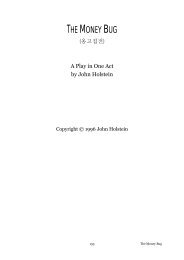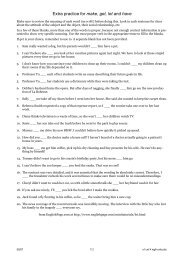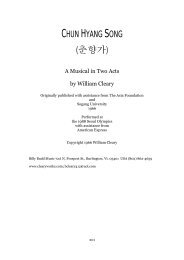The McCune-Reischauer Korean Romanization ... - Korea Mosaic
The McCune-Reischauer Korean Romanization ... - Korea Mosaic
The McCune-Reischauer Korean Romanization ... - Korea Mosaic
You also want an ePaper? Increase the reach of your titles
YUMPU automatically turns print PDFs into web optimized ePapers that Google loves.
<strong>The</strong> <strong>McCune</strong>-<strong>Reischauer</strong> <strong><strong>Korea</strong>n</strong> <strong>Romanization</strong> System<br />
John Holstein<br />
Transactions, Royal Asiatic Society Volume 74 - 1999<br />
(Update: Since this article was written, the <strong><strong>Korea</strong>n</strong> government implemented the “Revised<br />
<strong>Romanization</strong> of <strong><strong>Korea</strong>n</strong>.” This article provides a short history of romanization systems of<br />
hangul, explanation of differences between the systems, and some of the advantages and<br />
disadvantages of these systems.)<br />
<strong>The</strong> headline in the 14 January 1984<br />
issue of the <strong>Korea</strong> Times came as good<br />
news to the thousands of people who<br />
were looking for relief from the endless<br />
debate over which system would be<br />
used for romanizing <strong><strong>Korea</strong>n</strong>: “Gov’t to<br />
adopt M-R system.” <strong>The</strong> article explained<br />
that “<strong>The</strong> Education Ministry<br />
announced its policy to romanize <strong><strong>Korea</strong>n</strong><br />
words almost in strict observance<br />
of the <strong>McCune</strong>-<strong>Reischauer</strong> system yesterday,<br />
putting an end to the decadesold<br />
controversy over the matter.” At<br />
long last, after all these years of confusion,<br />
we could finally stop battling over<br />
which romanization system to use—<br />
until, in May of 1999, the message from<br />
Seoul National University Professor Lee<br />
Sang Oak appeared on the <strong><strong>Korea</strong>n</strong><br />
Studies Forum list: “…the NAKL [National<br />
Academy of the <strong><strong>Korea</strong>n</strong> Language]<br />
decided to re-open inquiry into the issue.”<br />
1 So the controversy continues.<br />
And it will probably continue as long as<br />
humans seek a better way, because neither<br />
the <strong><strong>Korea</strong>n</strong> nor the English writing<br />
system is equipped to represent all the<br />
rules of <strong><strong>Korea</strong>n</strong> pronunciation in a way<br />
that is entirely accurate, convenient<br />
and aesthetically pleasing.<br />
It is fitting that these notes have<br />
been provided in time to celebrate the<br />
venerable system’s hwan’gap in the<br />
year 1999.<br />
What is the M-R system used for<br />
<strong>The</strong> <strong>McCune</strong>-<strong>Reischauer</strong> romanization<br />
system was originally devised, in 1939,<br />
to satisfy the need for one standard romanization<br />
of <strong><strong>Korea</strong>n</strong>. <strong>The</strong> designers of<br />
the system did not attempt an exact notation<br />
that would include all the details<br />
of the language’s phonetic system, because<br />
that would have required using<br />
arcane symbols. “We have not intended<br />
that it be used in phonetic or in technical<br />
philological research. Rather, we<br />
have made it for general scholarly and<br />
non-scholarly use where phonetic symbols<br />
would be cumbersome and annoying<br />
and where strict phonetic exactness<br />
is not demanded. We have therefore attempted<br />
to effect a compromise between<br />
scientific accuracy and practical simplicity”<br />
(<strong>McCune</strong>, 1939). Neither did<br />
they attempt to represent to an exact<br />
degree the way <strong><strong>Korea</strong>n</strong> is written; they<br />
designed their system with the intention<br />
of providing a relatively simple<br />
method of representing what the language<br />
sounds like when it is spoken.<br />
<strong>The</strong> historical background on romanization<br />
systems for <strong><strong>Korea</strong>n</strong><br />
Though not the first romanization system<br />
for <strong><strong>Korea</strong>n</strong>, the Ross system, designed<br />
in 1882 2 , seems to be the first<br />
system used by a significant number of<br />
people, mainly missionaries. At the time<br />
of the creation of the M-R system, according<br />
to <strong>McCune</strong>, there were more<br />
than 27 systems. In 1997 the number<br />
was estimated at “more than 40” (Kim,<br />
1997). That is not surprising in light of<br />
the fact that a standardized <strong><strong>Korea</strong>n</strong> orthography<br />
did not appear until 1933,<br />
prior to which <strong><strong>Korea</strong>n</strong> was written according<br />
to pronunciation (which varied<br />
according to dialect) instead of language<br />
structure. <strong>The</strong> first system promulgated<br />
officially by the <strong><strong>Korea</strong>n</strong> government was<br />
the Ministry of Education system of<br />
1948 (based on the M-R system, with a<br />
few variations); subsequently, in 1959,<br />
the Ministry of Education adopted a<br />
system based on different principles,<br />
thereby causing much confusion and<br />
7/2/05 1/ 19 mr9912
dissatisfaction among those who used<br />
the M-R system. All this discontent<br />
brought about two more proposals, in<br />
1978 and 1979, and then, around 1982,<br />
after it was announced that <strong>Korea</strong><br />
would host the 1988 Olympics, a wide<br />
and vociferous discussion erupted,<br />
again between the anti- and pro-M.R.<br />
forces, culminating in the government<br />
announcement in 1984 that it would<br />
use a slightly modified M-R system.<br />
Over the next decade, however, discontent<br />
continued to simmer, and came to<br />
a boil again in 1997 with another debate.<br />
That debate subsided with no<br />
conclusion reached, simmered for another<br />
two years, and was brought back<br />
to full boil in 1999. (You can observe<br />
this discussion, continuing into 2000, if<br />
you subscribe to the <strong>Korea</strong> Studies forum<br />
at www.mailbase.com.) Meanwhile,<br />
since 1986, while controversy has continued<br />
inside <strong>Korea</strong>, outside <strong>Korea</strong> the<br />
International Standards Organization<br />
(ISO) has been consulting with the two<br />
<strong>Korea</strong>s over adoption of an ISO standard<br />
for romanization of Han’gûl.<br />
Development of the M-R system<br />
Donald Clark (1997) tells us how the M-<br />
R system was conceived and developed.<br />
George <strong>McCune</strong> was born in <strong>Korea</strong> to a<br />
Presbyterian missionary family who<br />
came to <strong>Korea</strong> in 1905. After graduating<br />
from a university in the United States<br />
he returned to <strong>Korea</strong> to continue his<br />
studies in East Asian history and pursue<br />
formal understanding of the <strong><strong>Korea</strong>n</strong><br />
language at Chosen Christian College<br />
(the present Yonsei University) under<br />
the distinguished <strong><strong>Korea</strong>n</strong> linguists<br />
Ch’oe Hyônbae and Chông Insôp. Many<br />
linguists of the time were dissatisfied<br />
with the existing romanization systems,<br />
in particular the system that the Japanese<br />
government had forced on <strong>Korea</strong>.<br />
(This system, designed more for romanization<br />
of Japanese, produced such<br />
anomalies as Tyosen for the more recognizable<br />
Chosen.) In the summer of<br />
1937 Edwin O. <strong>Reischauer</strong>, on his way<br />
to China to collect information for a paper<br />
he was writing in Japan, stopped in<br />
<strong>Korea</strong> and was then forced by political<br />
events in China to stay in <strong>Korea</strong> for a<br />
couple of months. During this period<br />
<strong>McCune</strong> and <strong>Reischauer</strong> began development<br />
of their romanization system<br />
with Ch’oe Hyônbae and other linguists;<br />
development continued after <strong>Reischauer</strong><br />
left, until the <strong>McCune</strong>-<br />
<strong>Reischauer</strong> system was published in<br />
1939, in that year’s Transactions of the<br />
Royal Asiatic Society.<br />
Chronology of significant date in the romanization<br />
of <strong><strong>Korea</strong>n</strong><br />
1835: Missionary W. H. Medhurst uses<br />
his unnamed and unpublished<br />
system in his translation of a<br />
book on Chinese, <strong><strong>Korea</strong>n</strong> and<br />
Japanese languages. 3<br />
1882: J. Ross’s system appears. 4<br />
1874: <strong>The</strong> Dallet (French) system introduces<br />
the commonly seen digraphs<br />
eo and eu. 5<br />
1897: J. S. Gale’s system is introduced<br />
in his A <strong><strong>Korea</strong>n</strong>-English Dictionary.<br />
1933: <strong>The</strong> <strong><strong>Korea</strong>n</strong> Language Research<br />
Society publishes “Rules for the<br />
Unification of Spelling to Conform<br />
to the Unified System,” and<br />
names its writing system Han’gûl.<br />
1935: Jung Insub publishes his system,<br />
“<strong>The</strong> International Phonetic Transcription<br />
of <strong><strong>Korea</strong>n</strong> Speech<br />
Sounds”. 6<br />
1939: <strong>The</strong> <strong>McCune</strong>-<strong>Reischauer</strong> system<br />
is presented in Transactions.<br />
1940: <strong>The</strong> <strong><strong>Korea</strong>n</strong> Language Society<br />
publicizes its “<strong>The</strong> <strong>Romanization</strong><br />
of <strong><strong>Korea</strong>n</strong> Sounds,” the first system<br />
devised entirely by <strong><strong>Korea</strong>n</strong>s.<br />
1948: <strong>The</strong> <strong><strong>Korea</strong>n</strong> government adopts<br />
the <strong>McCune</strong>-<strong>Reischauer</strong> system.<br />
1954: Samuel Martin presents his Yale-<br />
Martin system 7 for linguistic<br />
analysis.<br />
1956: <strong>The</strong> North <strong><strong>Korea</strong>n</strong> system (modified<br />
slightly in 1986) 8 is promulgated.<br />
1959: <strong>The</strong> Ministry of Education announces<br />
its change to a transliteration<br />
(spelling-based) system;<br />
from this point till 1984 different<br />
7/2/05 2/ 19 mr9912
government agencies use different<br />
systems.<br />
1979: <strong>The</strong> National Academy of Sciences<br />
proposes a revision of the<br />
1959 MOE system.<br />
1981: <strong>The</strong> Workshop Conference on <strong><strong>Korea</strong>n</strong><br />
<strong>Romanization</strong> is sponsored<br />
by the Center for <strong><strong>Korea</strong>n</strong> Studies,<br />
University of Hawaii. 9<br />
1982: Spirited public criticism of the<br />
1959 MOE system breaks out.<br />
1984: <strong>The</strong> <strong><strong>Korea</strong>n</strong> government adopts<br />
what is popularly known as the<br />
“Ministry of Education (MOE) system”<br />
10 (the <strong>McCune</strong>-<strong>Reischauer</strong><br />
system with minor alterations);<br />
this remains the official government<br />
system. 11<br />
1986: Discussions begin between the<br />
two <strong>Korea</strong>s for agreement on a<br />
proposal by the ISO (International<br />
Standards Organization) system.<br />
1996: A meeting is hosted by the National<br />
Commission for <strong>Romanization</strong><br />
to get opinions from <strong><strong>Korea</strong>n</strong>s<br />
and non-<strong><strong>Korea</strong>n</strong>s in the public involved<br />
in romanization. 12<br />
1997: <strong>The</strong> National Commission for<br />
<strong>Romanization</strong>, appointed by the<br />
Ministry of Culture and Sports, 13<br />
proposes government adoption of<br />
a spelling-based system (similar<br />
to the 1959 MOE system); a<br />
heated debate erupts in the press<br />
and on the Internet.<br />
1998: <strong>The</strong> Ministry of Culture and<br />
Sports proscribes all further debate<br />
on which system to use. 14<br />
1999: ISO subcommittee decides to review<br />
proposed romanization system<br />
3 years later, in order to provide<br />
time for full agreement between<br />
the two <strong>Korea</strong>s, with possible<br />
adoption as an ISO standard<br />
at that time. 15<br />
1999: <strong>The</strong> National Academy of the <strong><strong>Korea</strong>n</strong><br />
Language renews the debate<br />
on which system to use (Lee Sang<br />
Oak, 1999). Circulates a questionnaire<br />
in early October, and in<br />
November holds its first in a series<br />
of open hearings extending<br />
into 2000. 16<br />
<strong>The</strong> most popular romanization systems<br />
in the year 2000<br />
At present, four systems are widely<br />
used in <strong>Korea</strong>, exclusively or in combination.<br />
<strong>The</strong> Yale-Martin system is used by<br />
most linguists in their structural and<br />
phonological study of the <strong><strong>Korea</strong>n</strong> language.<br />
Most will agree with Fouser’s<br />
(1998b) statement that “<strong>The</strong> Yale-<br />
Martin system’s wide-spread use in<br />
scholarship makes it a de facto second<br />
system along with the current <strong>McCune</strong>-<br />
<strong>Reischauer</strong> system” (if we regard the<br />
1984 MOE system as one with the<br />
<strong>McCune</strong>-<strong>Reischauer</strong>).<br />
<strong>The</strong> M-R system is used by “foreign<br />
organizations, institutions and persons<br />
(diplomats, military officials 17 , mapmakers,<br />
librarians [including the United<br />
States’ Library of Congress, which made<br />
some revisions (Choi 1999)], authors,<br />
bibliographers, publishers and others),<br />
both inside and outside <strong>Korea</strong>” (Kaliher,<br />
1982, p. 44). <strong>The</strong> 1984 MOE system is<br />
also used by many <strong><strong>Korea</strong>n</strong>s and non-<br />
<strong><strong>Korea</strong>n</strong>s in an individual capacity and,<br />
of course, by <strong><strong>Korea</strong>n</strong> government departments<br />
and agencies in official government<br />
publications and correspondence,<br />
textbooks, road signs, and other<br />
English language functions under the<br />
jurisdiction of the government.<br />
Many <strong><strong>Korea</strong>n</strong>s and non-<strong><strong>Korea</strong>n</strong>s<br />
who use the M-R or 1984 MOE system<br />
actually borrow, consciously or unconsciously,<br />
consistently or inconsistently,<br />
the 1959 MOE system’s digraphs eo<br />
and eu (for the unrounded /o/ and /u/)<br />
to avoid the technical difficulties encountered<br />
in rendering the M-R system’s<br />
breve ( ˘ ); and they sometimes<br />
use b, d, g and j at the beginning of a<br />
word rather than the p, t, k and ch required<br />
by M-R and 1984 MOE when<br />
they think actual pronunciation warrants<br />
it.<br />
One system that is not in use now<br />
but may gain popularity one day is the<br />
proposed ISO transliteration system. It<br />
consists of two “methods” for representing<br />
consonants (two because the two<br />
<strong>Korea</strong>s have not yet agreed upon one)<br />
7/2/05 3/ 19 mr9912
and one method for vowels. <strong>The</strong> system<br />
is an interesting combination of the major<br />
systems discussed in this section.<br />
Method 1, preferred by the DPRK, uses<br />
the M-R system’s method (p, t, k and ch),<br />
and Method 2, preferred by the ROK,<br />
uses the 1959 MOE (b, d, g and j)<br />
method for the corresponding characters;<br />
Method 1, however, uses the Yale-<br />
Martin system’s method (kh, th, ph, ch;<br />
c) for representing aspirants and the<br />
affricate, respectively. <strong>The</strong> slightly<br />
rounded and unrounded vowels are<br />
represented by the 1959 MOE system’s<br />
method (eo and eu).<br />
Two ways of romanizing <strong><strong>Korea</strong>n</strong><br />
Han’gûl (the <strong><strong>Korea</strong>n</strong> orthographic system)<br />
is a highly sophisticated orthographic<br />
system which some romanization<br />
systems transliterate and some<br />
transcribe. Written <strong><strong>Korea</strong>n</strong>, like written<br />
English, does not represent exactly how<br />
the spoken language sounds. In English<br />
orthography, for example, we use the<br />
same o in the second syllable of both<br />
photograph and photography, even<br />
though pronunciation of the o is not the<br />
same; <strong><strong>Korea</strong>n</strong> orthography follows the<br />
same principle.<br />
<strong>The</strong> main difference in the romanization<br />
systems is whether they are either<br />
mainly transliteration or mainly<br />
transcription. Transliteration (1959<br />
MOE, Yale-Martin) puts emphasis more<br />
on how a language is written than on<br />
how it is pronounced (though the Yale-<br />
Martin system is also very informative<br />
about pronunciation 18 ); transcription<br />
(Mc-Cune <strong>Reischauer</strong>, 1984 MOE) emphasizes<br />
how the language is pronounced<br />
more than how it is written<br />
(though information on spelling can<br />
also be retrieved). <strong>The</strong>refore, a transliteration<br />
system represents <strong><strong>Korea</strong>n</strong> orthography<br />
exactly; <strong><strong>Korea</strong>n</strong> orthography<br />
does not use a different letter to show a<br />
slight variation (an allophone) in the<br />
pronunciation of a basic sound (a phoneme),<br />
and neither does this type of<br />
romanization system. A transcription<br />
system does show the change in pronunciation,<br />
by using a different letter;<br />
consequently, this kind of romanization<br />
system frequently differs from corresponding<br />
spelling in <strong><strong>Korea</strong>n</strong> orthography.<br />
Even the M-R system, though,<br />
does not represent every sound variation.<br />
19<br />
To illustrate the difference between<br />
the two romanization systems, take the<br />
<strong><strong>Korea</strong>n</strong> spelling for 속리산, the mountain:<br />
in spoken language the final consonant<br />
(ㄱ) of the first syllable 속 is<br />
/ng/, and the first consonant (ㄹ) of the<br />
second syllable is /n/. <strong>The</strong> 1959 MOE<br />
system romanizes 속리산 as Sogri-san<br />
and the Yale-Martin system romanizes<br />
it Sok.li-san. <strong>The</strong> M-R and 1984 MOE<br />
transcription systems, on the other<br />
hand, get a lot closer to actual pronunciation<br />
with Songnisan.<br />
Another example of the different<br />
ways these systems work is found in<br />
독립문, the name of an historic gate in<br />
Seoul. Transliteration, which focuses on<br />
language structure and attempts letterfor-letter<br />
accuracy, represents the word<br />
as Doglibmun (1959 MOE) or<br />
Tok.lip.mun (Yale-Martin). <strong>The</strong> transcribed<br />
romanization, though, is Tongnimmun,<br />
which, for those who do not<br />
know the less apparent rules of the<br />
transliteration systems, more accurately<br />
represents the word’s pronunciation.<br />
How the systems compare<br />
<strong>The</strong> chart below shows examples of how the different systems deal with problems in<br />
rendering <strong><strong>Korea</strong>n</strong> in English.<br />
Transcription<br />
Transliteration<br />
han’gûl feature M-R 1984 MOE 1959 MOE Yale-Martin<br />
7/2/05 4/ 19 mr9912
독립문<br />
속리산<br />
강릉<br />
consonant<br />
change<br />
consonant<br />
change<br />
consonant<br />
change (also<br />
note the unrounded<br />
vowel in<br />
the second syllable)<br />
Tongnimmun Tongnimmun Doglibmun tok.lip.mun<br />
Songnisan Songnisan Sogri-san Sok.li-san<br />
Kangnûng Kangnûng Gangreung Kang.lung<br />
부부 lenis (light) stops pubu pubu bubu pupu<br />
풀 aspirate stops p’ul p’ul or pul pul phul<br />
빵 forced stops ppang ppang bbang ppang<br />
제주도 affricates Cheju-do Cheju-do Jejudo Cēycwu-to<br />
전라북도<br />
slightly rounded<br />
vowel (also note<br />
the consonant<br />
change between<br />
first and second<br />
syllables)<br />
Chôllapuk-do<br />
Chôllapuk-do<br />
or Chollapukdo<br />
Jeonlabugdo<br />
or Jeonla<br />
Bugdo<br />
Cen.la pukto<br />
금잔디 unrounded vowel kûmjandi kûmjandi geumjandi kum-canti<br />
김정호<br />
Name syllabification<br />
Kim<br />
Chôngho<br />
Kim Chông-ho<br />
or Chong-ho<br />
Gim Jeong-ho<br />
Kim Chengho<br />
Problems in the systems currently in<br />
use<br />
1) Problems common to all the romanization<br />
systems<br />
No single romanization system, transliteration<br />
or transcription, satisfactorily<br />
represents both the pronunciation<br />
and grammar of <strong><strong>Korea</strong>n</strong> because of<br />
three features of the language: the existence<br />
of sounds that cannot easily<br />
be represented by Latin letters, differences<br />
in the way <strong><strong>Korea</strong>n</strong>s and non-<br />
<strong><strong>Korea</strong>n</strong>s perceive the same sounds,<br />
and the nature of <strong><strong>Korea</strong>n</strong> orthography.<br />
Thus, because English does not have<br />
single letters that satisfactorily represent<br />
the <strong><strong>Korea</strong>n</strong> sounds for 어 and 으,<br />
we must either use a diacritic that is<br />
difficult or impossible to produce on<br />
the ordinary typewriter or computer<br />
(M-R uses the breve), or digraphs (eo<br />
or au) that are either misleading, except<br />
to initiates, or differ in pronunciation<br />
according to circumstance.<br />
Because of difference in perception of<br />
sounds, a <strong><strong>Korea</strong>n</strong> perceives the initial<br />
ㄷ in 독립문 differently from the way<br />
an American hears it, and therefore<br />
wants to transcribe it differently from<br />
the way a native English speaker<br />
does. 20 (Rector, 1999, describes this<br />
and other lenis stops as “whispered<br />
and breathy,” different from an initial<br />
English /p/ or /b/.) In addition, because<br />
<strong><strong>Korea</strong>n</strong> orthography focuses on<br />
the language’s structure, we have two<br />
basic types of romanization systems<br />
(transliteration and transcription),<br />
each with limitations, and a continuing<br />
debate over which is the best type.<br />
In a message regarding the NAKL's<br />
1999 proposal to change the official<br />
government <strong>Romanization</strong> system yet<br />
again, John Harvey 21 points out that<br />
“<strong>The</strong> real question is not so much<br />
whether the current systems [sic] has<br />
drawbacks, or even whether some<br />
other system might be better, but<br />
whether adopting any other system<br />
would be worth 1) the huge amount of<br />
money required for making the<br />
7/2/05 5/ 19 mr9912
changes on road signs, in guidebooks,<br />
and so forth, 2) the long period of confusion<br />
between two systems while<br />
those changes are being made (which<br />
would undoubtedly last through the<br />
2002 World Cup), and 3) the probably<br />
division that would be created between<br />
the system coming into use in<br />
<strong>Korea</strong> and the system (M-R) being<br />
used by foreign scholars, governments,<br />
reference works, etc.” Gary Rector remarks<br />
that no system for representing<br />
han'gûl can be perfect and that every<br />
system will have elements that seem<br />
arbitrary or non-representational or<br />
are difficult to learn, and that the only<br />
way that any system can be made<br />
useful is by getting everyone to use it,<br />
which can be accomplished only by<br />
providing thorough and consistent<br />
training in its rules in school, government<br />
and the press.<br />
2) Problems with the individual systems<br />
Before getting into this section, two<br />
points must be made. First, all systems<br />
of orthography and romanization<br />
have problems when we expect from<br />
them what they were not intended to<br />
provide. Some systems cause more<br />
difficulty for native speakers, others<br />
cause more for non-native speakers.<br />
Second, the inclusion of a complaint<br />
in this section or of a proposal in the<br />
following section (regarding suggestions<br />
for improvement) does not signify<br />
this writer’s acknowledgment of<br />
its validity.<br />
Yale-Martin<br />
<strong>The</strong> main limitation of the Yale-Martin<br />
system is inherent in any transliteration<br />
system. Refer above to the “consonant<br />
change” rows in the table<br />
“How the systems compare” for examples<br />
of problems with inaccurate pronunciation;<br />
a transcription system<br />
represents pronunciation more accurately<br />
more easily for the person who<br />
does not know the system’s rules,<br />
which are not as immediately evident<br />
as those of a transcription system.<br />
Choe (1997b) provided a good example<br />
of what would happen if a <strong><strong>Korea</strong>n</strong><br />
used the transliteration system of<br />
strict letter-to-letter correspondence<br />
to write an English word in <strong><strong>Korea</strong>n</strong>.<br />
<strong>The</strong> name Al Gore would look something<br />
like and would be pronounced<br />
(with Italian vowels) something like<br />
/al go-re/.<br />
One other complaint made by<br />
those unfamiliar with the Yale-Martin<br />
system is that two of the letters that it<br />
uses, c for ㅈ and e for 어, do not apparently<br />
represent the sound of the<br />
<strong><strong>Korea</strong>n</strong> letters that they are intended<br />
to transcribe. A related complaint is<br />
that, while no <strong><strong>Korea</strong>n</strong> basic vowel is a<br />
diphthong, some vowels (ones which<br />
were historically diphthongs) seem to<br />
be presented as diphthongs in Yale-<br />
Martin (e.g., ay for 애). Uninitiates<br />
also have difficulty with the system’s<br />
many digraphs and trigraphs to represent<br />
<strong><strong>Korea</strong>n</strong> letters (e.g., th for ㄷ<br />
and yay for 얘 ); in a word comprised<br />
of single letters, digraphs and trigraphs,<br />
it is sometimes difficult to determine<br />
where one <strong><strong>Korea</strong>n</strong> letter begins<br />
and ends.<br />
2.a) <strong>The</strong> 1959 MOE System<br />
Because it is a transliteration system<br />
with inflexible letter-to-letter correspondence,<br />
like the Yale-Martin system,<br />
the 1959 MOE system does not<br />
provide a surface representation of the<br />
pronunciation.<br />
<strong>The</strong> main criticism of the 1959<br />
MOE system, however, is the use of<br />
English voiced stop letters b, d, and g<br />
to represent <strong><strong>Korea</strong>n</strong>’s unvoiced stops<br />
ㅂ, ㄷ , and ㄱ at the beginning of<br />
words: the result is often quite unpleasant<br />
to the English ear. Lee Sang<br />
Oak (1982 p. 8) explains that in English<br />
there is “a paralinguistic tendency<br />
that English uses voiced consonants<br />
for many coarse and inelegant words,”<br />
such as gag, dung, and bang. One<br />
famous instance of this problem is the<br />
1959 MOE system’s transliteration of<br />
the name of Independence Gate 독립문<br />
as Doglibmun. (<strong>The</strong> agency responsible<br />
for making the sign compounded the<br />
problem by mistakenly using r instead<br />
7/2/05 6/ 19 mr9912
of the required l, and then highlighted<br />
the problem by writing it in three<br />
separate syllables, ending up with a<br />
sign showing “Dog Rib Mun.”) Gary<br />
Ledyard noted a few more examples of<br />
transliterations that upset or amuse<br />
the English eye and ear: “...Jong Gag,<br />
Bug A Hyeon, Bug Gang, Rag Won,<br />
Young Hag, any of which could not<br />
only get you lost but cause a serious<br />
accident as well.”<br />
<strong>The</strong> problem with the /dog/ pronunciation<br />
is not inherent in a transcription<br />
system; it is caused by the<br />
developers’ decision to use d instead<br />
of t for ㄷ. <strong>The</strong> problems with g in dog¸<br />
and the l and the b in lib, though, are<br />
inherent in a transcription system,<br />
which does not attempt to account for<br />
the sound changes that result, in the<br />
case of <strong><strong>Korea</strong>n</strong>, when a ㄱ is followed<br />
by a ㄹ, and a ㅂ is followed by a ㅁ.<br />
<strong>The</strong> problem with /dog/ brings to<br />
mind another problem with this system:<br />
<strong>The</strong> d, g and b are somewhat<br />
misleading representations of the <strong><strong>Korea</strong>n</strong><br />
pronunciation; they strike the<br />
<strong><strong>Korea</strong>n</strong> ear strangely when pronounced<br />
by an English speaker unfamiliar<br />
with the conventions of this<br />
system. (In another way, the same can<br />
be said of the M-R system’s representation<br />
of these same consonants as t,<br />
k and p; this is discussed below.) <strong><strong>Korea</strong>n</strong>s<br />
do not voice b, d and g, but native<br />
English speakers who are unfamiliar<br />
with <strong><strong>Korea</strong>n</strong> tend to voice these<br />
letters because they are voiced in<br />
English.<br />
Many do not like the 1959 MOE<br />
choice of eo for 어 and eu for 으 , saying<br />
that it is another example of pronunciation<br />
misrepresentation and a<br />
cause of confusion. (Gary Rector wonders<br />
whether this digraph, originally<br />
used in Dallet’s system (1874), might<br />
have originated in the French spelling<br />
of Seoul. <strong>The</strong> eo in Seoul might come<br />
from the French pronunciation of e,<br />
similar to a <strong><strong>Korea</strong>n</strong>’s slightly rounded<br />
/o/. <strong>The</strong> French pronunciation ou is<br />
similar to the <strong><strong>Korea</strong>n</strong> rounded /u/. 22 )<br />
2.b) <strong>The</strong> <strong>McCune</strong>-<strong>Reischauer</strong> System<br />
Orthography: If one does not know the<br />
complex rules for transcription in the<br />
M-R system it is not possible to retrieve<br />
the Han’gûl spelling from the M-<br />
R spelling.<br />
Technical difficulties: <strong>The</strong> breve (˘ ),<br />
a diacritic mark placed above o and u<br />
to represent the slightly rounded /o/<br />
( 어 ) and the unrounded /u/ ( 으 ), is<br />
one of the major causes for complaint.<br />
In fact, it is one of the main reasons<br />
that the <strong><strong>Korea</strong>n</strong> government has been<br />
looking for an alternative to the M-R<br />
system over the last couple of years.<br />
<strong>The</strong> breve cannot be typed on an ordinary<br />
typewriter; many do not know<br />
how to produce it on a computer, and<br />
even when it does get produced it<br />
cannot be read in a program that does<br />
not use or is not set up for a compatible<br />
character-encoding system.<br />
<strong>The</strong> apostrophe has also received a<br />
lot of attention. This is used to mark<br />
both aspirate consonants and three<br />
potentially confusing syllable breaks.<br />
(<strong>The</strong> apostrophe is not used to clarify<br />
all syllable breaks that might possibly<br />
cause confusion. It marks only a’e, o’e<br />
and n’g.) <strong>The</strong> problem is said to be<br />
one of clutter, which can occur when<br />
an apostrophe that marks an aspirate<br />
appears in close proximity to an apostrophe<br />
that marks a syllable break.<br />
Inaccuracy: While phonetic accuracy<br />
was the authors’ main goal, both <strong><strong>Korea</strong>n</strong>s<br />
and non-<strong><strong>Korea</strong>n</strong>s have been<br />
wrestling with a few related problems<br />
since the birth of the system. Representing<br />
initial unaspirated and unvoiced<br />
consonants (such as ㄱ in Kim)<br />
with letters that represent unvoiced<br />
consonants in English (such as k)<br />
causes non-native speakers of <strong><strong>Korea</strong>n</strong><br />
to add unnecessary aspiration (Kim<br />
1996). <strong>The</strong> reader may have seen the<br />
cartoon in the <strong><strong>Korea</strong>n</strong> Herald a few<br />
months ago that showed the non-<br />
<strong><strong>Korea</strong>n</strong> asking (in Han’gûl) “Mr. K’im<br />
k’yeshimnigga” 미스터 킴 켸십니까, in<br />
which the ㄱ was aspirated ( ㅋ ). This<br />
7/2/05 7/ 19 mr9912
cartoon exaggerated the pronunciation<br />
problem, but one gets the point.<br />
Confusion: Lee Hyôn-bok, a linguist at<br />
Seoul National University, offered the<br />
widely-quoted complaint that the M-R<br />
system makes prostitute ( 창녀 ) and<br />
eldest daughter ( 장녀 ) sound the<br />
same when spoken by an English<br />
speaker who is unfamiliar with <strong><strong>Korea</strong>n</strong><br />
and the M-R system, because<br />
non-native English speakers tend to<br />
pronounce ch and ch’ the same (Kim-<br />
Renaud 1997). 23<br />
Klein (p. 19) reported that “Another<br />
criticism often leveled at the M-R system<br />
is that distinction in words may<br />
be lost. M-R kungmin, for example,<br />
could represent either 국민 (“national”)<br />
or 궁민 (“poor people”).<br />
Difficulty of transcription for <strong><strong>Korea</strong>n</strong>s:<br />
It is easier for <strong><strong>Korea</strong>n</strong>s to use a transliteration<br />
system like the 1959 MOE<br />
system because when they write “they<br />
think in hangul” (Fouser, 1998a), just<br />
as English speakers think in English<br />
orthography when they write. In this<br />
respect the M-R system is sometimes<br />
difficult for <strong><strong>Korea</strong>n</strong>s because they do<br />
not make the same phonemic distinctions<br />
as speakers of English do.<br />
<strong>McCune</strong> (p. 26, footnote 1) points out<br />
that “<strong>The</strong> average <strong><strong>Korea</strong>n</strong> does not<br />
distinguish between the voiced and<br />
unvoiced sounds of these plosives, as<br />
will be seen by the fact that both are<br />
written by the same ônmun [or<br />
Han’gûl] letter. On the other hand the<br />
average American or Englishman does<br />
not distinguish between <strong><strong>Korea</strong>n</strong> [lenis<br />
and aspirated] plosives. Three <strong><strong>Korea</strong>n</strong><br />
words illustrate this, p’al (arm), pal<br />
(foot) and sabal (bowl). To an American<br />
or an Englishman the difference<br />
between the first two is very difficult<br />
to note, and many foreigners pronounce<br />
them alike. <strong>The</strong> <strong><strong>Korea</strong>n</strong>, on<br />
the other hand, often insists that he<br />
pronounces the in pal and sabal<br />
the same, although the difference is<br />
striking to the western ear.” 24<br />
Origin: Some are against the M-R system<br />
for reasons other than linguistic.<br />
“<strong>The</strong> current system is dubious because<br />
it comes from a system developed<br />
by foreigners during the Japanese<br />
colonial occupation” (Kim<br />
1996). 25 Others dislike the M-R system<br />
because this system with two foreign<br />
names in its title is the basis for<br />
the widely-used system promulgated<br />
by the <strong><strong>Korea</strong>n</strong> government (the 1984<br />
MOE system), and if <strong><strong>Korea</strong>n</strong>s had the<br />
genius to create the great Han’gûl system,<br />
the government should be able to<br />
find <strong><strong>Korea</strong>n</strong>s with the ability to establish<br />
a satisfactory romanization system<br />
(Fouser, 1998b p. 17).<br />
Ideas for resolving the romanization<br />
problem<br />
In 1997 the Lingua <strong><strong>Korea</strong>n</strong>a Society<br />
conducted a survey of <strong><strong>Korea</strong>n</strong>s and<br />
non-<strong><strong>Korea</strong>n</strong>s residing in <strong>Korea</strong> to find<br />
out which of several romanization systems<br />
the surveyed thought most accurately<br />
reflect <strong><strong>Korea</strong>n</strong> pronunciation.<br />
<strong>The</strong> Society presented a long list of<br />
single words and names written in<br />
Han’gûl, along with their romanizations<br />
by the different systems. Almost<br />
57% favored the transcriptions of the<br />
M-R system; the next most popular<br />
were the transliterations of the<br />
“Hanse” system (Fouser 1998a p. 28).<br />
<strong>The</strong> opinion of most non-<strong><strong>Korea</strong>n</strong>s and<br />
many <strong><strong>Korea</strong>n</strong>s involved in the discussion<br />
over the last few years has been,<br />
“If it ain’t broke. . .”: continue to use<br />
both major existing systems, the morphophonemic<br />
Yale-Martin for linguistic<br />
analysis, and the phonetic<br />
<strong>McCune</strong>-<strong>Reischauer</strong> (not to exclude<br />
the 1984 MOE, which is almost identical)<br />
for other purposes. (Very few<br />
know of the Hanse system.) <strong>The</strong>re are<br />
also many, though, who would like to<br />
see the government adopt one system<br />
for all purposes, and there is no lack<br />
of notable candidates: the Revised<br />
Hanse system, Lee Hyun Bok’s, You<br />
Mahn-gun’s, Kim Bokmoon’s, an ISO<br />
(International Standards Organization)<br />
proposal on which North and<br />
South <strong>Korea</strong> are trying to come to<br />
agreement, and a Unified <strong><strong>Korea</strong>n</strong> <strong>Romanization</strong><br />
System, and yet others<br />
7/2/05 8/ 19 mr9912
(Fouser 1998b). As mentioned previously,<br />
the NAKL has added its system<br />
to this list.<br />
Some have tried to provide a helpful<br />
perspective to the debate, to simplify<br />
it, by asking two questions: Who,<br />
after all, is romanization for And<br />
what is it for Instead of simplifying<br />
the problem, however, these questions<br />
complicate it by adding one more unanswerable<br />
element to it. Proponents<br />
of each system naturally answer these<br />
questions in a way that bolsters the<br />
argument for their system. Some say<br />
that romanization is for foreigners,<br />
others that it is for <strong><strong>Korea</strong>n</strong>s; some insist<br />
that romanization is used mainly<br />
for foreigners to be able to read and<br />
pronounce <strong><strong>Korea</strong>n</strong> with relative accuracy,<br />
others that it is used mainly for<br />
<strong><strong>Korea</strong>n</strong>s to represent Han'gûl in writing.<br />
<strong>The</strong> fact that romanization is for<br />
all of these people and uses does not<br />
make simplify anything.<br />
However, since non-<strong><strong>Korea</strong>n</strong>s<br />
throughout the world almost exclusively<br />
support the M-R system for the<br />
purposes for which it was intended<br />
(even if they disagree with several of<br />
its individual features), as do a majority<br />
of <strong><strong>Korea</strong>n</strong>s, this system will most<br />
likely continue to be widely used,<br />
within <strong>Korea</strong> and without. <strong>The</strong> M-R<br />
system remained pre-eminent no matter<br />
which system the government<br />
adopted, and the ISO system currently<br />
under review, even when it becomes<br />
a standard, is a transliteration<br />
system used in situations which do<br />
not require a transcription system like<br />
the M-R. <strong>The</strong> question here, then, is<br />
not so much which system to use as<br />
how to resolve the problems in the M-<br />
R system.<br />
Various proposals for fixing problems<br />
in the M-R system<br />
This is a representative collection of<br />
the many ideas that have been proposed,<br />
over the last few years, in the<br />
interest of improving the system’s<br />
ease of use and its phonetic accuracy.<br />
A complete listing would go on for<br />
pages; as for the value of these opinions,<br />
we do not have enough space<br />
here to present all the interesting pros<br />
and cons that have been voiced over<br />
the years.<br />
Lenis stops (k/g, t/d, p/b)<br />
• Extend use of the voiced consonant<br />
letters (b, d, g) to initial positions<br />
when the final sound in the<br />
preceding word necessitates this.<br />
For example, the word for moon<br />
( 달 ) is represented as tal no matter<br />
where it is located in a phrase<br />
because t is used for lenis stops at<br />
the beginning of a word, but this<br />
proposal would change the t to d<br />
when the word is in a medial position<br />
in a phrase and follows an n<br />
in the preceding word (big moon:<br />
k’ûn dal) (Sohn, p. 55, Rector<br />
1997b). <strong>The</strong> M-R system requires<br />
this change only “in the middle of<br />
a word,” not a phrase (<strong>McCune</strong> p.<br />
28-29).<br />
Aspirate marking<br />
• Substitute the letter h for the<br />
apostrophe to mark the aspirate<br />
consonants: ph, th, kh, chh, instead<br />
of p’, t’, k’, ch’.<br />
• A mark is needed, because it is often<br />
essential to know whether the<br />
consonant is an aspirate or not,<br />
and context does not help when<br />
the reader is dealing with names.<br />
Continue using the apostrophe;<br />
the h is deficient aesthetically and<br />
can be confusing to one who does<br />
not have familiarity with the language<br />
or the M-R system.<br />
• Simply eliminate the apostrophe,<br />
and use voiced consonant letters<br />
for initial lenis stops.<br />
Syllable boundary marking<br />
• Eliminate the apostrophe that is<br />
used to show syllable boundaries<br />
(a’e, o’e, and n’g).<br />
• Replace the apostrophe with a<br />
slash. <strong>The</strong> slash would indicate a<br />
syllable break more clearly than<br />
the apostrophe, is not as conspicuous<br />
as the apostrophe (it<br />
makes less white space), and<br />
7/2/05 9/ 19 mr9912
would reduce confusion and clutter<br />
by allowing the apostrophe to<br />
be used exclusively for marking<br />
aspirates.<br />
• Replace the apostrophe with a hyphen.<br />
Marking the unrounded vowels<br />
• Use eo and eu.<br />
• Use upper case. For example,<br />
ChOllapuk-do and Han’gUl.<br />
• Omit any mark when meaning is<br />
clear without it.<br />
• Replace the breve with another<br />
diacritic mark (circumflex, umlaut,<br />
acute, or grave accent mark) that<br />
is available in all software and<br />
works on the Internet. “Almost any<br />
accent mark can be used. Preferably,<br />
of course, it will not be one<br />
which suggests a phonetic value to<br />
many readers, like the umlaut—ö<br />
and ü... I would suggest the circumflex—ô<br />
and û—which has the<br />
virtue of being available as a separate<br />
character on probably all keyboards,<br />
so that, in a pinch, we can<br />
use o^ and u^” (Harvey 1996).<br />
(Some put the circumflex before<br />
the letter.) See the key combinations<br />
table in the endnotes for creating<br />
the circumflex right above<br />
the letter, 26 but be warned that the<br />
reader of your e-mail will probably<br />
see garble 27 . “<strong>The</strong> circumflex is a<br />
good replacement for the breve because<br />
it is visually similar and because<br />
many computer users now<br />
use it informally as a replacement<br />
for the breve” (Fouser 1998 p. 30).<br />
“…No matter what diacritic you<br />
use, many editors and any publisher<br />
can run a universal ‘search<br />
and replace’ and produce the<br />
standard <strong>McCune</strong>-<strong>Reischauer</strong> diacritic<br />
throughout your text so long<br />
as you have adopted a given diacritic<br />
and used it consistently and<br />
unambiguously” (Ledyard 1997).<br />
• Leave it be. <strong>The</strong> computer industry<br />
will provide a standard code for<br />
creation and reading of the breve<br />
soon enough. A breve is provided<br />
in Unicode, a recent alternative to<br />
ASCII code. Unicode is quickly<br />
gaining support from the software<br />
industry (operating systems, applications<br />
and Internet). Soon it will<br />
simply be a matter of whether the<br />
software of the intended reader is<br />
set to show the breve. 28<br />
Conclusion<br />
From its publication in 1939 to its<br />
hwan’gap in 1999 the <strong>McCune</strong>-<br />
<strong>Reischauer</strong> system has remained the<br />
preeminent transcription romanization<br />
system for han’gûl. It is logical to<br />
assume that it has retained its popularity<br />
because its developers had<br />
enough knowledge and foresight to<br />
deal with the intractable problems of<br />
representing han’gûl in an orthography<br />
so impossibly different from it in<br />
the best ways available to us.<br />
<strong>The</strong> nature of language prevents<br />
any romanization system—for any<br />
language on this earth—from ever<br />
fully representing the pronunciation<br />
of that language. People get used to a<br />
well-wrought system, though, and the<br />
problematic features that might have<br />
seemed so difficult to live with at the<br />
relative beginning of the system become<br />
second nature with consistent<br />
use and the passage of years, much<br />
like English speakers have got used to<br />
the different sounds for the same letters<br />
and different letters for the same<br />
sounds in their language. And we are<br />
probably not being unduly optimistic<br />
to believe that one day, in <strong>Korea</strong> too,<br />
no one will give a second thought to<br />
using a p for a sound that is neither<br />
/p/ nor /b/.<br />
REFERENCES<br />
Austerlitz, Robert. (1980). Report of the workshop conference on <strong><strong>Korea</strong>n</strong> romanization.<br />
<strong><strong>Korea</strong>n</strong> Studies, 4. 111-125.<br />
7/2/05 10/ 19 mr9912
Choe, Yong-shik. (1997, May 24). New Hangul romanization plan likely to put foreigners<br />
into great confusion. <strong>The</strong> <strong>Korea</strong> Times. pp. 1, 2.<br />
Choe, Yong-shik. (1997, May 26). Proposed Hangul romanization plan unrealistic,<br />
impractical. <strong>The</strong> <strong>Korea</strong> Times. pp. 1, 10.<br />
Choi, Hyonggun. (1999, January 8). Re: how to write <strong><strong>Korea</strong>n</strong> names in English Retrieved<br />
from the <strong><strong>Korea</strong>n</strong>-Studies list on the World Wide Web:<br />
http://www.mailbase.ac.uk.<br />
Clark, Donald N. (1997, July). How the <strong>McCune</strong> system got started. <strong><strong>Korea</strong>n</strong> Studies<br />
Newsletter, 62. p. 1, 2. University of Hawaii, Center for <strong><strong>Korea</strong>n</strong> Studies.<br />
Dege, Eckart. (1997, July). <strong>Romanization</strong> redux. <strong><strong>Korea</strong>n</strong> Studies Newsletter, 62. p.<br />
1. University of Hawaii, Center for <strong><strong>Korea</strong>n</strong> Studies.<br />
Fouser, Robert J. (1998a). Putting market forces to work: the rationale for two romanization<br />
systems of <strong><strong>Korea</strong>n</strong>. Occasional Papers—<strong>Romanization</strong> of <strong><strong>Korea</strong>n</strong>, 1.<br />
Seoul: Lingua <strong>Korea</strong> Society.<br />
Fouser, Robert J. (1998b, July 19-24). Nationalism and globalism in transliteration<br />
systems: <strong>Romanization</strong> debates in <strong>Korea</strong>. Paper presented at the 6th IPrA Conference,<br />
Reims, France.<br />
Government-adopted romanization system. (1984, January 14). <strong>The</strong> <strong>Korea</strong> Times.<br />
Harvey, John H. T. (1996, December 13). <strong>Romanization</strong> meeting. Notes presented at<br />
a meeting on romanization chaired by Song Ki-jung, sponsored by <strong>The</strong> <strong><strong>Korea</strong>n</strong> Language<br />
Research Center, Seoul.<br />
Harvey, John H. T. (1999). Tables and notes on <strong>McCune</strong>-<strong>Reischauer</strong> romanization.<br />
Seoul: Royal Asiatic Society, <strong>Korea</strong>.<br />
Hoffmann, Frank. (1999, May 19, 20). <strong>Romanization</strong> ’99. Retrieved from the <strong><strong>Korea</strong>n</strong>-Studies<br />
list on the World Wide Web: http://www.mailbase.ac.uk.<br />
Jung, Insub. (1935). <strong>The</strong> international phonetic transcription of <strong><strong>Korea</strong>n</strong> speechsounds.<br />
Seoul: Dong-A Ilbo.<br />
Kaliher, Kenneth L. (1997, May 8). Unpublished manuscript.<br />
Kaliher, Kenneth L. (1982). Once more with fearing: romanization in 1982. <strong>Korea</strong><br />
Journal, 22(8). 44-48.<br />
Kang, Sung-chul. (1983, March 3). Ministries split over romanizing Hangul. <strong>The</strong> <strong>Korea</strong><br />
Herald.<br />
Kim, Chin-man. (1984, February 14). <strong>Romanization</strong> aimed at Western ears. <strong>The</strong> <strong>Korea</strong><br />
Herald. p. 6<br />
Kim, Ki-hang. (1997, May 29). <strong>Romanization</strong> of <strong><strong>Korea</strong>n</strong>. <strong>The</strong> <strong>Korea</strong> Herald.<br />
Kim-Renaud, Young-Key. (1997, May 9). Subject: <strong>McCune</strong>-R system. Retrieved from<br />
the <strong><strong>Korea</strong>n</strong>-Studies list on the World Wide Web: http://www.mailbase.ac.uk.<br />
Klein, Edward F. (1982.) <strong>Romanization</strong> of <strong><strong>Korea</strong>n</strong>: Do armchair linguists have the<br />
answer <strong>Korea</strong> Journal, 22(8).<br />
Ledyard, Gary Keith. (1997, May 8). Re: <strong>McCune</strong>-R System. Retrieved from the <strong><strong>Korea</strong>n</strong>-Studies<br />
list on the World Wide Web: http://www.mailbase.ac.uk.<br />
Lee, Hyun Bok. (1982.) <strong>Romanization</strong> of <strong><strong>Korea</strong>n</strong>: In defense of the MOE system. <strong>Korea</strong><br />
Journal, 22(8).<br />
Lee, Sang Oak. (1982.) <strong>The</strong> second best compromise: the National Academy of Sciences’<br />
proposal on romanization in <strong><strong>Korea</strong>n</strong>. <strong>Korea</strong> Journal, 22(8).<br />
Lee, Sang Oak. (1983, February 20). Optimum romanization for ‘Koreigners’. <strong>The</strong><br />
<strong>Korea</strong> Times.<br />
7/2/05 11/ 19 mr9912
Lee, Sang Oak. (1999, May 2). <strong>Romanization</strong> ’99. Retrieved from the <strong><strong>Korea</strong>n</strong>-Studies<br />
list on the World Wide Web: http://www.mailbase.ac.uk.<br />
<strong>McCune</strong>, George, <strong>Reischauer</strong>, E. O. (1939). <strong>The</strong> romanization of the <strong><strong>Korea</strong>n</strong> language<br />
based upon its phonetic structure. Transactions of the <strong>Korea</strong> Branch of the<br />
Royal Asiatic Society, 29. 1-55.<br />
Muller, Charles. (1998, April 29). Re: ocrp and word. Retrieved from the <strong><strong>Korea</strong>n</strong>-<br />
Studies list on the World Wide Web: http://www.mailbase.ac.uk<br />
New romanization system adopted for <strong><strong>Korea</strong>n</strong> words. (1984, January 14). <strong>The</strong> <strong>Korea</strong><br />
Herald.<br />
(<strong>The</strong>) Official system of romanization for <strong><strong>Korea</strong>n</strong> currently in use and its problems.<br />
(1996, 13 December). Notes presented at a meeting on romanization chaired by<br />
Song Ki-jung, sponsored by <strong>The</strong> <strong><strong>Korea</strong>n</strong> Language Research Center, Seoul.<br />
Park, Moo-jung. (1997, May 9). ‘Tongnimmun’ vs. ‘Dogribmwun’. <strong>The</strong> <strong>Korea</strong> Times.<br />
Rector, Gary. (1997, June 1). <strong>Romanization</strong>. A suggestion for a compromise system<br />
of romanizing <strong><strong>Korea</strong>n</strong>. Retrieved from the <strong><strong>Korea</strong>n</strong>-Studies list on the World Wide<br />
Web: www.mailbase.ac.uk.<br />
Rector, Gary. (1997, October 15). <strong>Romanization</strong> and mispronunciation. Retrieved<br />
from the <strong><strong>Korea</strong>n</strong>-Studies list on the World Wide Web: www.mailbase.ac.uk.<br />
Rector, Gary. (1999, June 28). Hungbo’s Gourd: From mists to monsoons. <strong>The</strong> <strong>Korea</strong><br />
Herald.<br />
Royal Asiatic Society. (1961). <strong>The</strong> romanization of <strong><strong>Korea</strong>n</strong> according to the <strong>McCune</strong>-<br />
<strong>Reischauer</strong> system. Transactions of the <strong>Korea</strong> Branch of the Royal Asiatic Society,<br />
38. 121-128.<br />
Shiffman, James R. (1985, August 9-10). Naming names can cause <strong><strong>Korea</strong>n</strong>s much<br />
confusion. Asian Wall Street Journal.<br />
Sohn, Ho-min. (1982). <strong>Romanization</strong> of <strong><strong>Korea</strong>n</strong>: a cross-phonemic approach. <strong>Korea</strong><br />
Journal, 22(8).<br />
1 As of June 28, the matter was still being discussed in a lower committee of the NAKL (Lee<br />
Sang Oak, personal communication).<br />
2 Conflicting information: Lee (1982, p. 6) says 1882. Fouser (1998b) says 1877: “<strong>Romanization</strong><br />
of <strong><strong>Korea</strong>n</strong> dates back to 1832, when a German doctor, Philipp Franz J. B. van Siebold…developed<br />
a romanization system for <strong>Korea</strong>…. Several other systems were devised in<br />
the mid-19th century, but three, the Siebold system (1832), the Dallet system (1874) and<br />
the Ross system (1877) exerted the strongest influence on later systems.”<br />
3 “As early as in 1835, a polyglot with such a long title as Translation of a comparative Vocabulary<br />
of the Chinese, Corean and Japanese, to Which is Added the thousand Character<br />
Classic, in Chinese and Corean, the Whole Accompanied by Copious Indexes of All the Chinese<br />
and English Words Occurring in the Work was published in Batavia in Indonesia by the<br />
English missionary, W.H. Medhurst. As a matter of fact, this polyglot was a reproduction of<br />
7/2/05 12/ 19 mr9912
the Chinese (Written)-Japanese-<strong><strong>Korea</strong>n</strong> Glossary of the 18th century published by the Bureau<br />
of Interpreters in the government of the Chosun dynasty of <strong>Korea</strong>.” This information is<br />
included in an article entitled “<strong>The</strong> Official System of <strong>Romanization</strong> for <strong><strong>Korea</strong>n</strong> Currently in<br />
Use and Its Problems,” presented at a meeting on romanization in December of 1996,<br />
chaired by Song Ki-jung.<br />
4 Entries from 1882 to 1979 from Lee Sang Oak (1982; p.6).<br />
5 “<strong>The</strong> Dallet family of systems uses the same consonants [as the M-R system], but indicates<br />
aspiration with an h added to each consonant (kh, th, and ph). <strong>The</strong> use of the h continues<br />
to this day in the official North <strong><strong>Korea</strong>n</strong> romanization system and the Yale-Martin system<br />
used mainly by linguists. <strong>The</strong> Dallet system set another precedent with the use of the e<br />
with another vowel to indicate the two vowels…which become eo and eu’… “<strong>The</strong> use of eo for<br />
and eu for<br />
is still popular because the breve used over o and u, respectively, for these<br />
letters is so inconvenient for many people” (Fouser, 1998b). “<strong>The</strong> first European priest to<br />
cross the border was Pierre Maubant … That was in 1836, and presumably…began the first<br />
of three-dozen <strong>Romanization</strong> systems that have been made and unmade for the last hundred<br />
years… <strong>The</strong> French mission made their system public in 1881, but the substance of<br />
the system can be gleaned from Dallet’s History of the <strong><strong>Korea</strong>n</strong> Church published in the<br />
1870s… <strong>The</strong> biggest nuisance to [Dallet] was the first sound of the two-syllable name<br />
of…Seoul. He was not at all sure about the value of that very common sound, so he offered<br />
for that single sound three optional notations: o, eu, and e. He adopted the last of his three<br />
options to produce the historic ‘Seoul’ which may be as thoroughly French as Londres,<br />
though no Frenchman could read it and come up with anything remotely approximate to<br />
how the natives say it” (Kim, 1984).<br />
6 Lee Sang Oak (1982, p. 6): “Ross’s system (1882)...is worth noting as a sort of predecessor<br />
to Jung’s system (1935).” Fouser (1998b): 1936.<br />
7 Lee Sang Oak (1982, p. 7 footnote).<br />
8 Fouser (1998b). “North <strong>Korea</strong> was the first to come up with a new romanization system.<br />
<strong>The</strong> current system of <strong>Romanization</strong> in North <strong>Korea</strong> dates from 1956 and was modified<br />
7/2/05 13/ 19 mr9912
slightly in 1986. It combines features from the Dallet (1874) system and the 1933 Unified<br />
Orthography system [for <strong><strong>Korea</strong>n</strong> spelling].”<br />
9 Sohn (1982) p. 53. Also presented here in this article are recommendations made at the<br />
Workshop.<br />
10 Ministry of Education Proclamation 84-1, January 13, 1984.<br />
11 Schiffman (1985).<br />
Kang 1983: “<strong>The</strong> Ministry of Education, which is in charge of formulating a unified spelling<br />
system to romanize <strong><strong>Korea</strong>n</strong> words, is using the traditional system it developed in 1959. <strong>The</strong><br />
Ministry of Education (MOE) system is used in school textbooks. Unlike the Education Ministry,<br />
the Ministry of Construction and the Seoul City government recently decided to use<br />
the <strong>McCune</strong>-<strong>Reischauer</strong> system in romanizing the names of streets and places. In the<br />
meantime, to prevent further confusion in the romanization of <strong><strong>Korea</strong>n</strong> words, the Education<br />
Ministry last year asked a special committee at the National Academy of Sciences to draft a<br />
unified spelling system for romanizing <strong><strong>Korea</strong>n</strong> words… <strong>The</strong> special committee…drafted a<br />
new romanization method for <strong><strong>Korea</strong>n</strong> words by combining the MOE system and the M-R<br />
method. <strong>The</strong> ministry, however, has not decided whether to adopt the new method as a final<br />
solution.”<br />
Fouser (1998b): “Complaints about the 1959 MOE system and wide popular use of the<br />
<strong>McCune</strong>-<strong>Reischauer</strong> system…caused the Ministry of Education [to] reexamine the issue in<br />
the early 1980s… <strong>The</strong> system put in place in 1984 is, except for a few minor changes, the<br />
same as the 1939 <strong>McCune</strong>-<strong>Reischauer</strong> system. This system takes the opposite approach<br />
from the 1959 system in that it attempts to approximate the <strong><strong>Korea</strong>n</strong> pronunciation by representing<br />
surface-level phonological changes. Each Han’gûl graph is therefore represented<br />
by one or two Roman letters. <strong>The</strong> system uses the breve diacritic mark above the o and u to<br />
create additional vowels. It also uses an apostrophe to represent the aspirated <strong><strong>Korea</strong>n</strong> consonants.”<br />
Also see the discussion “Government-adopted <strong>Romanization</strong> System” (<strong>Korea</strong> Times, 14<br />
January 1984) and “Changes in <strong>Romanization</strong>” table in “New romanization system adopted<br />
for <strong><strong>Korea</strong>n</strong> words” (<strong>Korea</strong> Herald, 14 January 1984).<br />
7/2/05 14/ 19 mr9912
12 This Commission was established by the National Academy of the <strong><strong>Korea</strong>n</strong> Language, a<br />
government agency under the Ministry of Culture and Sports.<br />
13 Kim-Renaud (1997): “<strong>The</strong>re is not a single nonnative speaker present at the meeting[s of<br />
the Commission]… Language and writing affairs have been under the jurisdiction of the<br />
Ministry of Culture and Sports for some time now, not the MOE [Ministry of Education]…<br />
<strong>The</strong>y have finally arrived at a consensus that they would work for a ‘one-to-one’ transliteration,<br />
not very different from the Yale-Martin system, except that they would change the ,<br />
, to , , and doubling these letters for the tense [doubled letter] series.”<br />
Lee (1999): This tentative proposal was presented by the National Academy of the <strong><strong>Korea</strong>n</strong><br />
Language, but was aborted after intense and widespread discussion “because of a lack of<br />
public consensus and [also because of] uneasiness about the economic crisis in the middle<br />
of 1997.”<br />
Kaliher (1997): “…the government ruled that the Ministry of Education’s (MOE) 1959 system<br />
be implemented on road signs nationwide, thus propagating such spellings as ‘Dogribmun’<br />
for Independence Gate, and fueling a wealth of associated jokes. (A couple of examples:<br />
<strong>The</strong> MOE spelling for Cholla Pukto, or North Cholla Province, inspired the riddle,<br />
‘What does a Jeonra Bugdo that no other bug does’ And a blackboard graffito used the<br />
MOE spelling of Park Chung Hee’s name to announce, ‘<strong>The</strong> new <strong>Romanization</strong> system has<br />
been approved by President Bag.’)…Foreign travelers could be forgiven for wondering why<br />
many of the signs on the road to Kangnung read ‘Gangreung.’ (Gangrene jokes abounded.).”<br />
Lee (1983): “Dogribmun, a typical example of awkward <strong>Romanization</strong> that many “Koreigners”…have<br />
enjoyed poking fun at, is in fact an illegitimate version of “Doglibmun” produced<br />
by a silly transcriber among the sign-painting authorities. According to my scrutiny of the<br />
Ministry of Education’s 1959 system, its first ‘note’ says that<br />
after any consonant<br />
should be written l rather than r: e.g., Sinla.”<br />
Kim-Renaud (1997): <strong>The</strong>re was a public hearing on May 6, with no foreigners in attendance,<br />
“although the meeting was announced in every newspaper, radio, and TV.” However, the<br />
1997 meeting sponsored by the <strong><strong>Korea</strong>n</strong> Language Research Center, attended by several<br />
Americans, was an attempt to get the input of foreigners.<br />
7/2/05 15/ 19 mr9912
14 Hanguk Ilbo (1998): “<strong>The</strong> Ministry of Culture and Sports, which overseas the National<br />
Academy of the <strong><strong>Korea</strong>n</strong> Language, announced at the end of June 1998 that all further debate<br />
on changing the official romanization system be stopped because of a lack of funds<br />
and national consensus for the change.”<br />
15 At its July 1999 meeting the ISO Subcommittee for Conversion of Written Languages<br />
(ISO/TC 46/SC2) decided to postpone adoption of the Technical Report “ISO/TR 11941<br />
(Transliteration of <strong><strong>Korea</strong>n</strong> script into Latin characters)” as an ISO standard (Clews, personal<br />
communication 14 July 1999). For more information, see http://www.elot.gov/tc46sc2 and<br />
http://asadal.cs.pusan.ac.kr/han-tl-ts.<br />
16 <strong>The</strong> NAKL was accused by many <strong><strong>Korea</strong>n</strong>s and non-<strong><strong>Korea</strong>n</strong>s of having ultranationalistic<br />
reasons for attempting to get the Ministry of Culture and Tourism to adopt its proposal, and<br />
the NAKL director's admonition, “When in Rome do as the Romans do,” along with the<br />
Academy's dissemination of a questionnaire only to <strong><strong>Korea</strong>n</strong>s and its announement of an<br />
open hearing for the proposal only a couple days previous to the hearing did not help defend<br />
it against these charges.<br />
<strong>The</strong> three principles that the NAKL claims to have followed in drafting the system are:<br />
1. “to be written as pronounced in <strong>Korea</strong>,<br />
2. not to use any symbol other than the Roman alphabet,<br />
3. to write one sound with one letter” [Harvey, personal communication, 18 Nov. 99; Harvey<br />
goes on to point out ways in which the system does not consistently follow all of these principles;<br />
search the archives of www.mailbase.com, <strong><strong>Korea</strong>n</strong> Studies, for the full text and many<br />
more communications about this matter. Also search the November and December 1999<br />
archives of <strong>The</strong> <strong>Korea</strong> Herald and <strong>The</strong> <strong>Korea</strong> Times.]<br />
Major proposed changes: Replace the M-R breve with eo and eu for the unrounded vowels,<br />
use g, d, b, and j for initial lenis stops (instead of M-R's k, t, p and ch), represent aspirated<br />
consonants with k, t, p and ch (instead of with the apostrophe used in M-R), ignore liaison<br />
(to better represent spelling).<br />
17 In an article opposing the NAKL's 1999 initiative to replace the M-R system, Han Dongsoo,<br />
Political Editor for <strong>The</strong> <strong>Korea</strong> Times, points out that “<strong>The</strong> United States Forces <strong>Korea</strong>,<br />
7/2/05 16/ 19 mr9912
which uses the <strong>McCune</strong>-<strong>Reischauer</strong> romanization system, will have to make a decision on<br />
whether to follow the new linguistic guidelines. However, it is a near certainty that the<br />
USFK will not accept it. . . Will the Pentagon order the wholesale revision of military maps<br />
and the names of its military targets in North <strong>Korea</strong>--Yongbyon into Yeongbyeon…for instance<br />
What will happen to the coordination of ROK-U.S. combined forces when they use<br />
different maps and pronounce their target locations differently Can these hypotheses be<br />
dismissed as groundless fears” (Quoted in Bryan R. Ross's message to the <strong><strong>Korea</strong>n</strong> Studies<br />
list, 1 Dec 1999.)<br />
18 Gary Rector provides an example of the q’s function: In the word Sinselq.tong, the q<br />
shows that the t is glottalized because of the preceding l. This information does not appear<br />
in either Han’gûl or the M-R system.<br />
19 “M-R violates its phonetic principle... by writing the silent y in kye, rye, and hye and the<br />
silent û in hûi” (Harvey, 1999), and by maintaining one spelling for the possessive marker ûi.<br />
20 “Users of the Roman alphabet have their own phonemic interdistinctions quite different<br />
from those of <strong><strong>Korea</strong>n</strong>s, thus perceiving certain different <strong><strong>Korea</strong>n</strong> phonemes as the same<br />
sounds and the same phonemes as different. Thus, for example, Americans perceive /bul/<br />
( ) ‘fire’ and /p’ul/ ( ) ‘grass’ as the same pul, while perceiving the same phoneme<br />
in kakeuk ( ) ‘opera’ as two different significant sounds, as in kagûk” (Sohn 51).<br />
21 <strong><strong>Korea</strong>n</strong> Studies list, 11 Dec 99.<br />
22 See Footnote 4.<br />
23 Critics of this complaint question its validity. One reason is that the aspirate mark in the<br />
M-R system makes the difference perfectly clear: “In the first case, the M-R romanizations of<br />
and are different, and the presence of the unexpected ‘apostrophe’<br />
in the latter word will serve to indicate to even the least initiated non-speaker of <strong><strong>Korea</strong>n</strong><br />
that some sort of ‘extra phonological knowledge’ is required. And that extra knowledge<br />
is present WITHIN the romanization system itself. That is, the sign has a consistent<br />
pronunciation within the system” (Kosofsky, 1997). Another reason critics question the validity<br />
of this complaint is that a person who would not know enough to distinguish between<br />
7/2/05 17/ 19 mr9912
these two words would not likely be having a <strong><strong>Korea</strong>n</strong>-language conversation in which these<br />
more sophisticated words would appear.<br />
24 “…the M-R system is very difficult for <strong><strong>Korea</strong>n</strong>s to use unless they get some training, because<br />
it requires using different Roman letters for one and the same <strong><strong>Korea</strong>n</strong> phoneme or<br />
Hang’ul letter. This is particularly the case with the initial lax consonants which are spelled<br />
p, t, k, ch and the medial counterparts which are spelled b, d, g, j” (Sohn, p. 55).<br />
25 Actually, <strong>McCune</strong> and <strong>Reischauer</strong> developed their system in close consultation with Ch’oe<br />
Hyônbae and Chông Insôp, highly respected linguistics scholars of the time. Besides, the<br />
1959 MOE system that many linguistic nationalists champion is based on the system that<br />
another foreigner, Ross, developed in 1882.<br />
26 This table presents some of the methods for creating a circumflex.<br />
Mac/U.S. IBM/U.S. –<br />
Word (Windows95x) b<br />
International a<br />
ô Alt+i, then o Alt+0244 Ctrl+Shift+^, o<br />
û Alt+i, then u Alt+0242 Ctrl+Shift+^, u<br />
Ô Shift+Alt+j Alt+0212 Ctrl+Shift+^, O<br />
Û Alt+i, then Shift+u Alt+0219 Ctrl+Shift+^, U<br />
Table notes:<br />
With all of these methods, keep in mind that the reader must have software that can read<br />
these symbols. Also, the correct “character encoding” settings in the reader’s software must<br />
be made. (Some e-mail programs do not provide this function.)<br />
aEnable the number pad..<br />
bOr in Insert-Font-Symbols, select the “normal text” circumflex o, u, O, or U, then assign a<br />
shortcut key before closing the box.<br />
<strong>The</strong> information in the “Mac/U.S.” and “IBM/U.S. –International” columns was provided by<br />
Frank Hoffman (1999). <strong>The</strong> information in the “Word (Windows95x)” column comes from<br />
John Harvey.<br />
27 Gary Rector, in personal communication, presented three variables to consider when using<br />
computer diacritics in e-mail: “1) Is the [reader's] browser capable of reading the Unicode<br />
Latin Extended-A characters (<strong>The</strong> main modern browsers can handle Unicode.), 2)<br />
Does the reader have at least one font that contains those characters and are they encoded<br />
in that font to the same codes as they are in Unicode Latin Extended-A, 3) Does the reader<br />
7/2/05 18/ 19 mr9912
have the browser set up to use that encoding and that font (Most people just use the default<br />
settings.)”<br />
28 For more information, see www.unicode.org.<br />
7/2/05 19/ 19 mr9912


